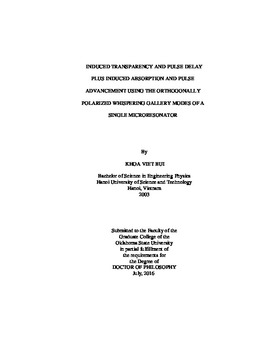| dc.contributor.advisor | Rosenberger, Albert Thomas | |
| dc.contributor.author | Bui, Khoa Viet | |
| dc.date.accessioned | 2017-02-22T22:08:41Z | |
| dc.date.available | 2017-02-22T22:08:41Z | |
| dc.date.issued | 2016-07 | |
| dc.identifier.uri | https://hdl.handle.net/11244/48786 | |
| dc.description.abstract | In this dissertation, the major research is to produce induced transparency and pulse delay or induced absorption and pulse advancement using orthogonally polarized whispering gallery TE and TM modes of a single microresonator (either microsphere or hollow bottle resonator). For background, we introduce the three-level atomic Lambda system, interacting with a probe field and a much stronger coupling field, in which destructive interference between the direct and indirect absorption paths between the ground and excited levels of the system produces the induced transparency feature in the probe transmission (EIT). Autler-Townes splitting (ATS) of the transmitted power occurs when the coupling field is strong. Constructive interference caused by the transfer of coherence and transfer of population between the hyperfine sublevels of the ground and excited states of the system can produce an induced absorption feature (EIA). These EIT/ATS and EIA effects enable slow and fast light. Next, we describe the coupled resonator induced transparency and absorption effects (CRIT, and CRIA). Due to the evanescent coupling between the coresonant whispering-gallery modes of the same polarization from two microspheres, the net throughput power in the coupled resonator system has features analogous to the EIT and EIA phenomena described previously. Then, we introduce two new methods to produce the EIT/EIA-like features of throughput power. The first method relies on the intracavity coupling between two orthogonally polarized TE and TM modes of very different quality factor Q when one mode (either TE or TM) is driven, and the second method uses the superposition of the orthogonal throughputs (in the absence of intracavity cross polarization mode coupling) when the two modes are simultaneously driven. In both cases, the throughput has the same polarization as the input. We refer to the behavior observed using the first method as coupled mode induced transparency and absorption (CMIT, CMIA) and the behavior of the second method as coresonant polarization induced transparency and absorption (CPIT, CPIA). Some predictions of the scattering model of these processes are presented here. In addition, the experiment-fitting by using both scattering and rotational models for CMIT/ATS with pulse delay and CMIA with both pulse delay and pulse advancement when using with microsphere and hollow bottle resonator are presented | |
| dc.format | application/pdf | |
| dc.language | en_US | |
| dc.rights | Copyright is held by the author who has granted the Oklahoma State University Library the non-exclusive right to share this material in its institutional repository. Contact Digital Library Services at lib-dls@okstate.edu or 405-744-9161 for the permission policy on the use, reproduction or distribution of this material. | |
| dc.title | Induced transparency and pulse delay plus induced absorption and pulse advancement using the orthogonally polarized whispering gallery modes of a single microresonator | |
| dc.contributor.committeeMember | Ackerson, Bruce J. | |
| dc.contributor.committeeMember | Bandy, Donna K. | |
| dc.contributor.committeeMember | Summy, Gil S. | |
| dc.contributor.committeeMember | West, James C. | |
| osu.filename | BUI_okstate_0664D_14768.pdf | |
| osu.accesstype | Open Access | |
| dc.type.genre | Dissertation | |
| dc.type.material | Text | |
| thesis.degree.discipline | Photonics | |
| thesis.degree.grantor | Oklahoma State University | |
